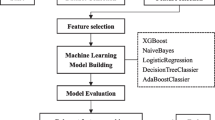Abstract
The negative impact of stroke on society has led to a concerted effort to improve stroke management and diagnosis. As the synergy between technology and medical diagnostics grows, caregivers are creating opportunities for better patient care by systematically exploring and archiving patient records. The ubiquitous growth of artificial intelligence and its medical applications has improved the efficiency of healthcare systems for patients requiring long-term personal care. Today, chronic diseases such as stroke are the world’s leading cause of death. Stroke can be caused by a number of factors. By measuring recorded values of patient characteristics such as heart rate, cholesterol levels, blood pressure, diabetes etc., this information can help doctors to make decisions about patient care, in order to predict a possible onset of the disease. Because most stroke diagnosis and prediction systems are image analysis tools such as CT or MRI, which are expensive and not available 24/7 in some African hospitals in general and Senegal in particular. We therefore use a dataset to predict stroke and compare its results with those of other models using the same data. We find that Xgboost, depending on the characteristics of the data, is the algorithm that can effectively predict stroke, and the results obtained are superior to those of other models.
Access this chapter
Tax calculation will be finalised at checkout
Purchases are for personal use only
Similar content being viewed by others
References
Sivapalan, G., Nundy, K., Dev, S., Cardiff, B., John, D.: ANNet: a lightweight neural network for ECG anomaly detection in IoT edge sensors. IEEE Trans. Biomed. Circ. Syst. 16(1), 24–35 (2022)
Pastore, D., Pacifici, F., Capuani, B., et al.: Sex-genetic interaction in the risk for cerebrovascular disease. Curr. Med. Chem. 24, 2687–2699 (2017)
The top 10 causes of death. https://www.who.int/news-room/factsheets/detail/the-top-10-causes-of-death. Accessed 22 June 2023
Koh, H.C., Tan, G.: Data mining applications in healthcare. J. Healthc. Inf. Manag. 19(2), 64–72 (2011)
Yoo, I., et al.: Data mining in healthcare and biomedicine: a survey of the literature. J. Med. Syst. 36(4), 2431–2448 (2012). https://doi.org/10.1007/s10916-011-9710-5
Meschia, J.F., et al.: Guidelines for the primary prevention of stroke: a statement for healthcare professionals from the American Heart Association/American Stroke Association. Stroke 45(12), 3754–3832 (2014)
Harmsen, P., Lappas, G., Rosengren, A., Wilhelmsen, L.: Long-term risk factors for stroke: twenty-eight years of follow-up of 7457 middle-aged men in Goteborg, Sweden. Stroke 37(7), 1663–1667 (2006)
Nwosu, C.S., Dev, S., Bhardwaj, P., Veeravalli, B., John, D.: Predicting stroke from electronic health records. In: 2019 41st Annual International Conference of the IEEE Engineering in Medicine and Biology Society (EMBC), Berlin, pp. 5704–5707. IEEE (2019)
Pathan, M.S., Jianbiao, Z., John, D., Nag, A., Dev, S.: Identifying stroke indicators using rough sets. IEEE Access 8, 210318–210327 (2020)
Kim, J., Hong, D., Park, S.: A case-control study of risk factors for cerebrovascular disease. J. Prev. Med. 28, 473–486 (1995)
Park, J.K., Kang, M.G., Kim, C.-B., et al.: A meta-analysis on the risk factors of cerebrovascular disorders in Koreans. J. Prev. Med. Public Health 31, 27–48 (1998)
Shi, Y., et al.: Risk factors for ischemic stroke: differences between cerebral small vessel and large artery atherosclerosis aetiologies. Folia Neuropathol. 59(4), 378–385 (2021)
Hanifa, S.M., Raja-S, K.: Stroke risk prediction through nonlinear support vector classification models. Int. J. Adv. Res. Comput. Sci. 1, 4753 (2010)
Clissold, B.B., Sundararajan, V., Cameron, P., et al.: Stroke incidence in Victoria, Australia—emerging improvements. Front. Neurol. 8, 180 (2017)
Rana, S., et al.: Application of machine learning techniques to identify data reliability and factors affecting outcome after stroke using electronic administrative records. Front. Neurol. 12, 670379 (2021)
Khosla, A., Cao, Y., Lin, C.C.Y., Chiu, H.K., Hu, J., Lee, H.: An integrated machine learning approach to stroke prediction. In: Proceedings of the 16th ACM SIGKDD International Conference on Knowledge Discovery and Data Mining, pp. 183–192 (2010)
Hung, C.Y., Lin, C.H., Lan, T.H., Peng, G.S., Lee, C.C.: Development of an intelligent decision support system for ischemic stroke risk assessment in a population-based electronic health record database. PLoS ONE 14, e0213007 (2019)
Teoh, D.: Towards stroke prediction using electronic health records. BMC Med. Inform. Decis. Making 18(1), 1–11 (2018)
Hung, C.Y., Chen, W.C., Lai, P.T., Lin, C.H., Lee, C.C.: Comparing deep neural network and other machine learning algorithms for stroke prediction in a large-scale population-based electronic medical claims database. In: 2017 39th Annual International Conference of the IEEE Engineering in Medicine and Biology Society (EMBC), pp. 3110–3113. IEEE (2017)
Fed Soriano, Stroke Prediction Dataset. https://www.kaggle.com/datasets/fedesoriano/stroke-prediction-datase. Accessed 23 June 2023
Author information
Authors and Affiliations
Corresponding author
Editor information
Editors and Affiliations
Rights and permissions
Copyright information
© 2024 ICST Institute for Computer Sciences, Social Informatics and Telecommunications Engineering
About this paper
Cite this paper
Anne, S., Gueye, A.D. (2024). XGBoost Algorithm to Predict a Patient’s Risk of Stroke. In: Seeam, A., Ramsurrun, V., Juddoo, S., Phokeer, A. (eds) Innovations and Interdisciplinary Solutions for Underserved Areas. InterSol 2023. Lecture Notes of the Institute for Computer Sciences, Social Informatics and Telecommunications Engineering, vol 541. Springer, Cham. https://doi.org/10.1007/978-3-031-51849-2_10
Download citation
DOI: https://doi.org/10.1007/978-3-031-51849-2_10
Published:
Publisher Name: Springer, Cham
Print ISBN: 978-3-031-51848-5
Online ISBN: 978-3-031-51849-2
eBook Packages: Computer ScienceComputer Science (R0)




